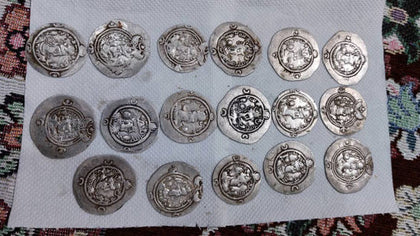Silver Coin Hoard Found with OKM eXp 6000

Detected with
OKM eXp 6000 Professional Plus
Depth: 1.8 m (5.9 ft)
Region: Iran

The Sassanid Empire: Persia in its Golden Age
The Sassanid Empire (224–651 AD) was one of the most influential powers of Late Antiquity — a realm glowing with culture, innovation and architectural brilliance. Stretching across today’s Iran, Iraq, Armenia, Azerbaijan and even touching regions of Central and South Asia, the empire flourished under Zoroastrian influence, thriving trade along the Silk Road and formidable political strength.
Grand monuments like the Anahita Temple and the breathtaking Taq-e Kisra still testify to this era of cultural bloom. Although eventually conquered by Muslim Arab forces, the legacy of the Sassanids continues to shape modern Persian identity, echoing in archaeological sites, museums and centuries-old stories that remain alive today.
Silver Coins of the Sassanids — History Minted in Metal
A treasure hunter using the 3D ground scanner OKM eXp 6000 made a remarkable discovery: a collection of Sassanid silver coins, still shimmering with history.
As a dominant power along the Silk Road, the Sassanid Empire relied heavily on coinage — not only for trade, but also as a political statement. Kings used their coins to project authority, celebrate victories and reinforce cultural identity. These ornate silver coins are more than artifacts; they are voices from a glorious past, helping us understand the rise, power and fall of an extraordinary civilization.


The coins discovered represent only a portion of the full treasure. Several pouches contained further silver pieces, many depicting rulers with distinct crowns — an important clue for dating each coin. Among them were coins minted under:
- Yazdegerd III — the last Sassanid king, ruling during the empire’s final struggle.
- Chosrau II — remembered as the last powerful and successful ruler of the dynasty.
Their reigns bookend the rise and collapse of the empire — one flourishing, one fighting to survive.
Chosrau II — The Last Great King
Chosrau II (r. 590–628 AD) presided over one of the most prosperous chapters of the Sassanid Empire. His reign was marked by military expansion and the famous Persian-Byzantine wars. Although victories initially strengthened the empire, shifting fortunes ultimately led to his downfall. Still, his reign remains a symbol of Sassanid ambition and power.
Yazdegerd III — The Empire’s Final Flame
Yazdegerd III (r. 632–651 AD), Chosrau II’s grandson, took the throne during a deeply unstable period. With internal unrest and the advancing Arab Muslim forces, he faced challenges no ruler could have overcome. His death in 651 AD marked the final chapter of the Sassanid Empire — and the beginning of a new era in the region.
OKM eXp 6000 — Technology That Brings History to Light
The Sassanid silver coins were detected at a depth of 1.80 m (5.9 ft) using the OKM eXp 6000 — one of OKM’s most advanced 3D ground scanners.
Capable of identifying objects at depths up to 25 m (82 ft), the eXp 6000 combines precision, power and intuitive operation, making it the perfect companion for treasure hunters who aim to reveal ancient secrets hidden far below the surface.


FAQ: Sassanid Coins and OKM eXp 6000
How deep can the OKM eXp 6000 detect objects?
Depending on soil conditions and object size, the eXp 6000 can detect items at depths up to 25 m (82 ft). The Sassanid coins in this case were located at 1.80 m.
What makes Sassanid coins historically valuable?
Their detailed minting, depiction of rulers and symbolism provide crucial insights into the politics, religion and economy of Late Antique Persia.
Can beginners use the eXp 6000 successfully?
Yes — the device is designed to be intuitive. With some basic training, even newcomers can achieve professional-level results.
How can different Sassanid rulers be identified on coins?
Mainly through their crowns. Each ruler had a unique crown shape, making identification surprisingly straightforward.
Is treasure hunting legal in every country?
No. Laws differ widely. Always check local regulations, obtain landowner permission and comply with heritage protection rules before searching.
Get Rewarded for Your Treasure Finds
You have also made discoveries and detected amazing artifacts and would like to share them (anonymously)? We look forward to reading and publishing your success stories!


